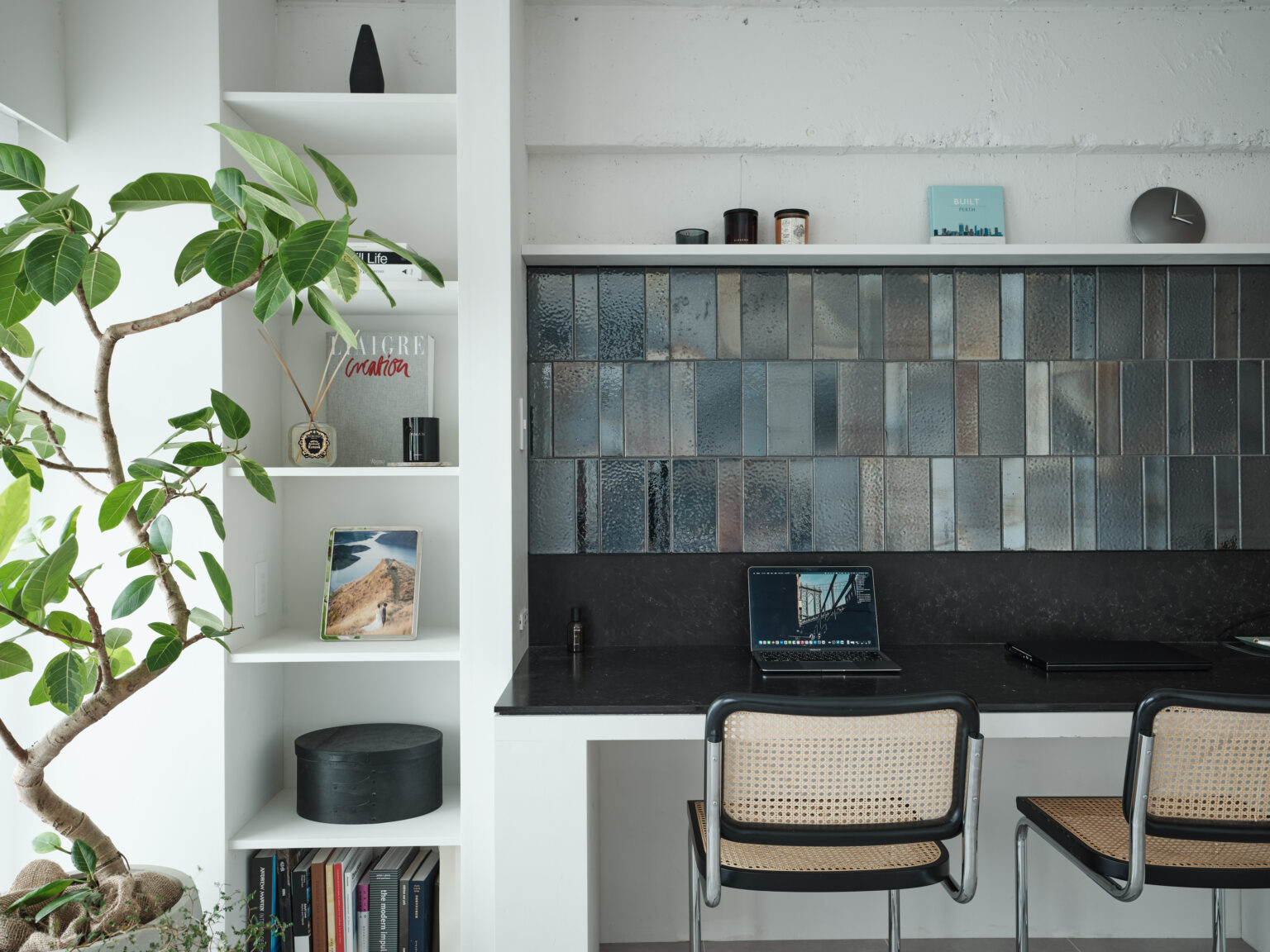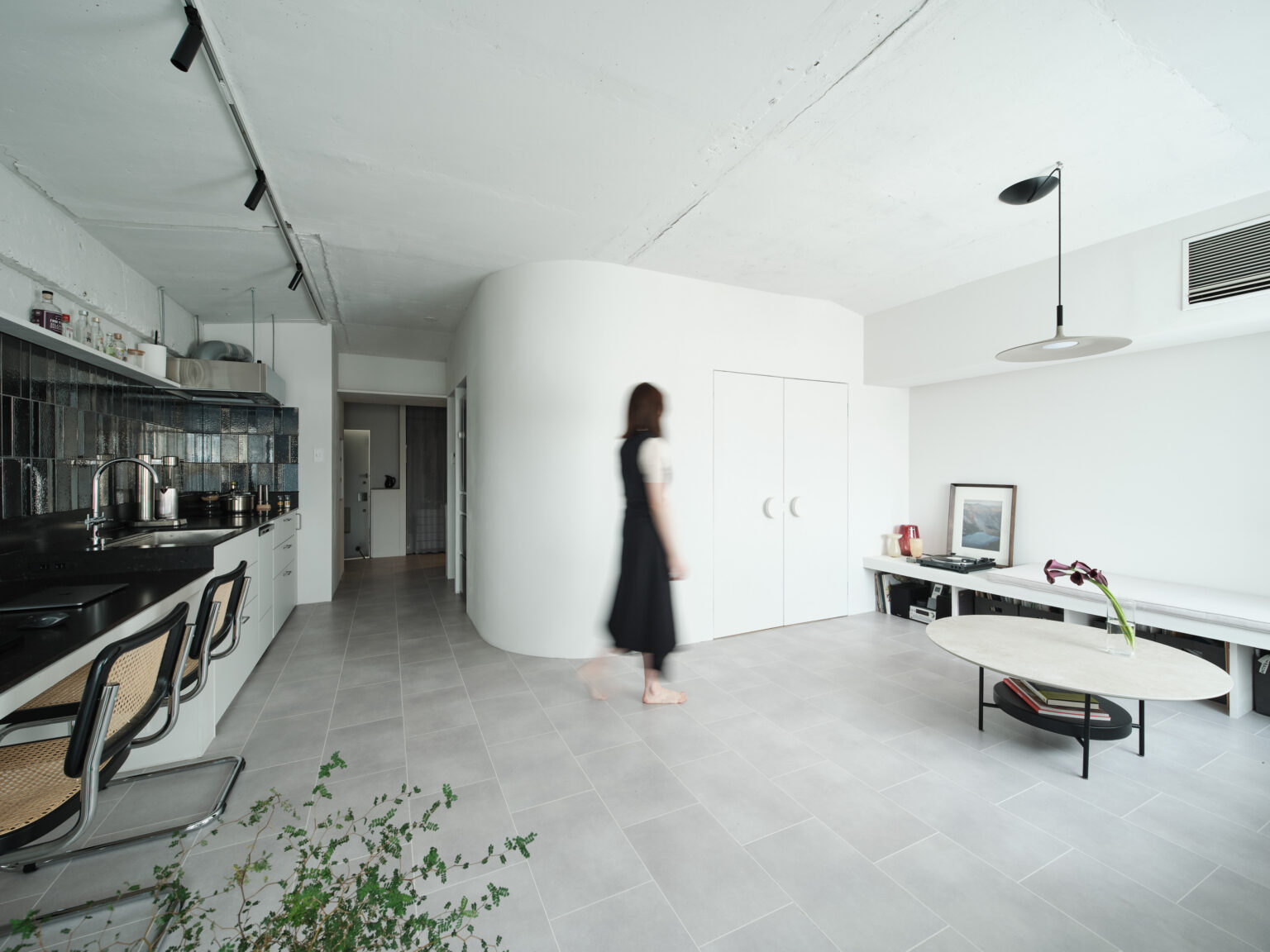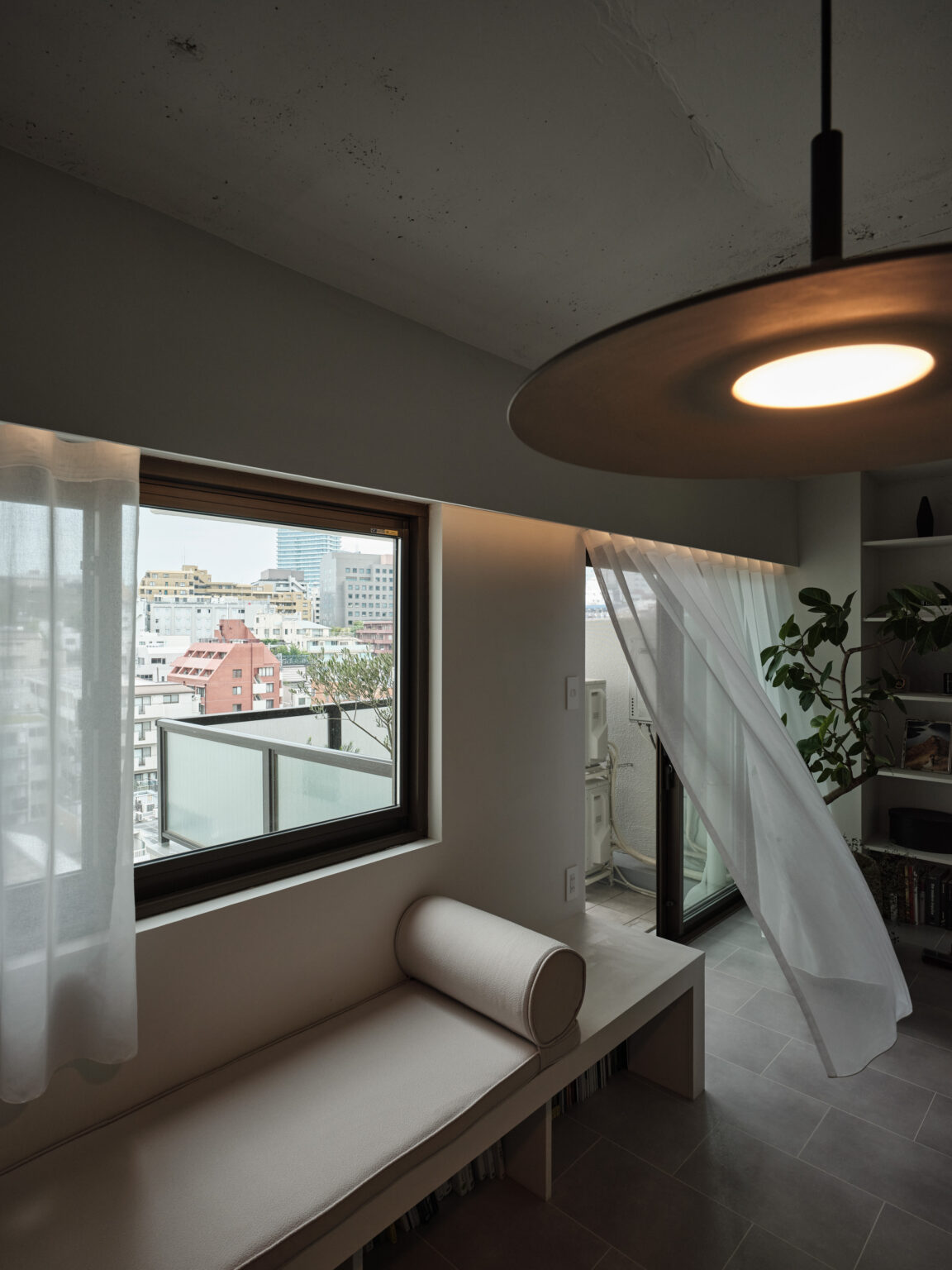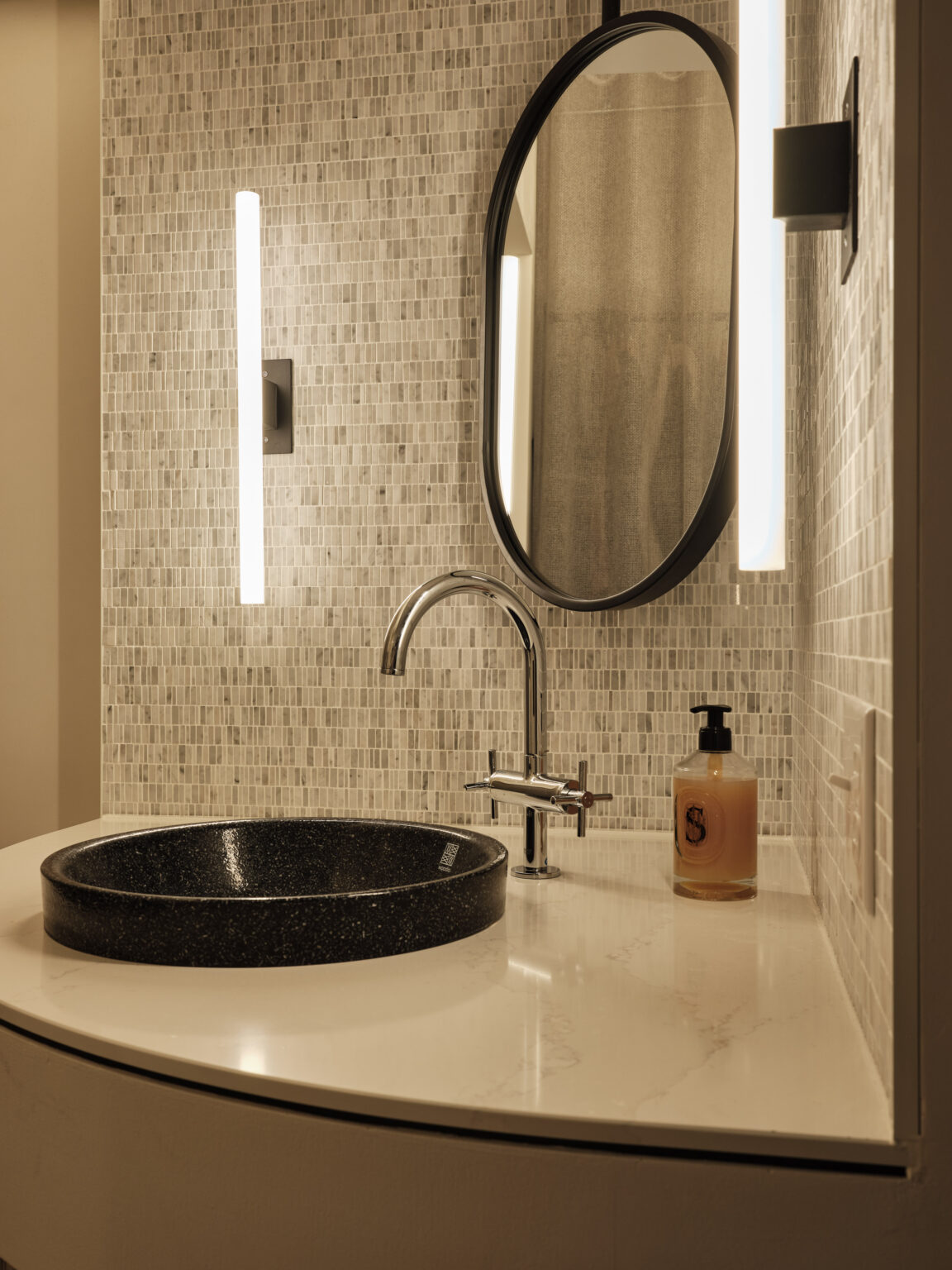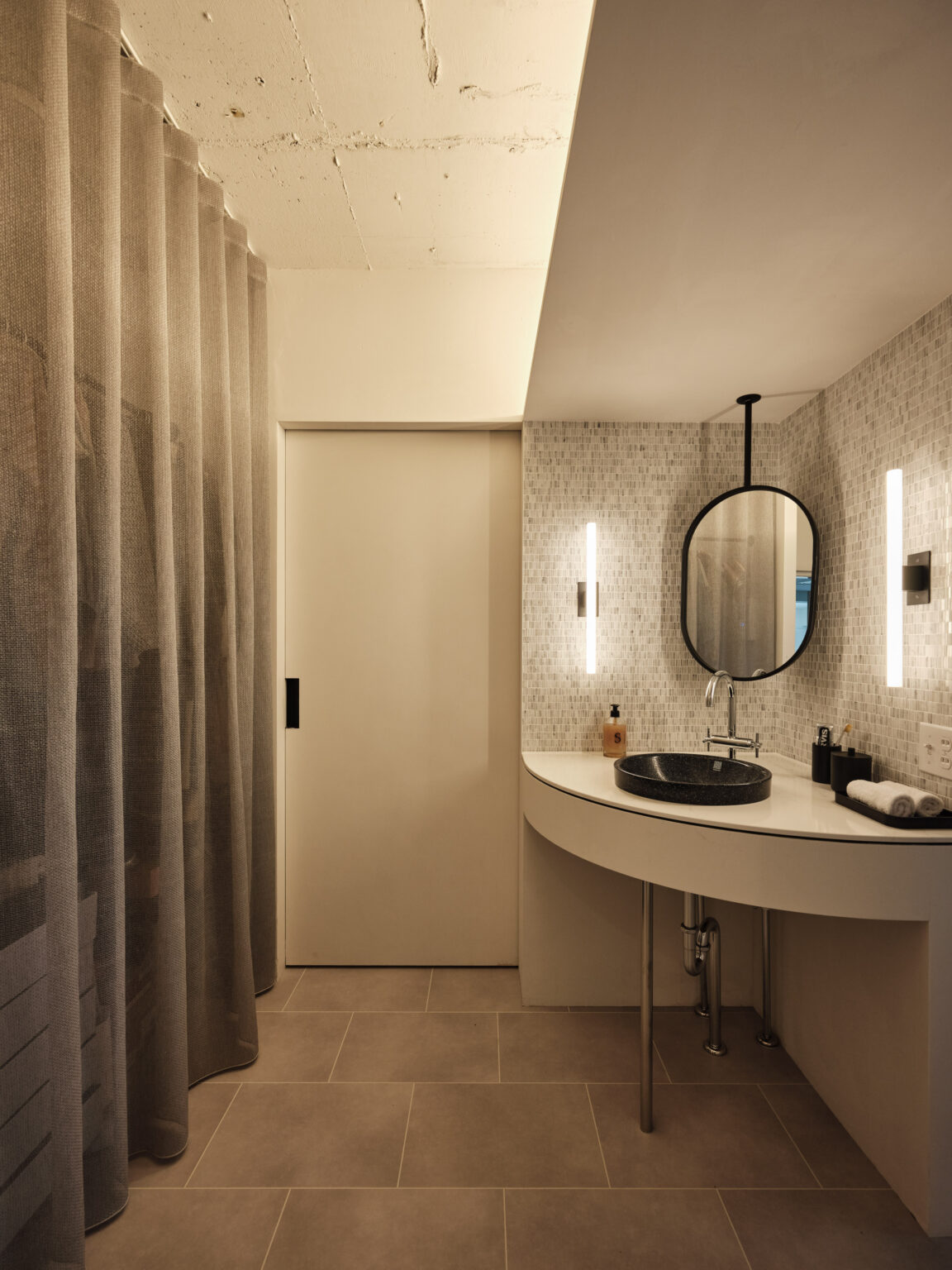シゴト
WORKS 280AKASAKA BOUNDS

AKASAKA BOUNDS
新婚⽣活は、それまで異なる⼈⽣を歩んできた他⼈を⾃分の内部に許容していく⼿続きのようなものだ。異なる価値観との出会いは新鮮であると同時に、新鮮という⾔葉の中には刹那的な寂しさを含む。素晴らしい冒険に、ふと感じる切なさを感じる時があるように。建築は時に、そんな⼀期⼀会の切なさを形にすることがある。
冒険の刹那的な美しさを⽇常に。テーマは「最⾼峰ホテル無限泊」。昨年新婚旅行で訪れたニュージーランドとオーストラリアで得られた地球的な美しさを、⾃分たちの⽣活空間に落とし込む俗人的で刹那的な感情の記録⾏為として、自邸の設計を始めた。
敷地は港区の閑静な住宅街に位置し、比較的大型の旧耐震マンションの一戸となる。周辺に大きな建築がない住居地域に属するため、南西に大きく開いたバルコニーに出ると、文字通り赤坂の「坂の多い」地形の上にそのまま住戸がへばりついたような、都市のジオロジカルな一面に接続することができる。
4m×6.3mのRCラーメンユニットが基本グリッドである中、入口までの半スパン分に対して全階贅沢に床を抜き、宙に浮いたアプローチ廊下だけが半スパン分を占めている。残りの1.5ユニットが専有部室内に該当し、そこから1/4ユニット分(2.7m×3.1m)跳ねだしたバルコニーは、明らかに専有部内の屋内用途を目的として豊かに設計されている。専有部を挟む贅沢なアプローチとバルコニーは既存空間の最大の魅力であり、東京の喧騒を豊かな住生活に変換する装置として十全に機能している。
玄関ホールは、上述のドラマティックなアプローチの贅沢なスケール感を大きく象徴的に受け止める必要があると考えた。そのうえで、南側のバルコニーをエントランスから予感させることも、既存建築の空間の魅力を最大化する上で必要な所作ととらえていた。既存DSが壁側に張り付き、大梁下の天高が有効で1900程度となることから、大梁下の空間に洗面台を配置しゲートのように設計した。帰宅して手を洗い、都市空間から住空間にスイッチングする場であり、あるいは出発するときの身だしなみを確認し、都市空間にスイッチングする場にもなる。スイッチングする行為をそのまま空間化することで、「ON-OFFの境界」としてのエントランスホールを再定義することを試みた。
共働き夫婦にとって平日は寝室が9割を占める空間であり、日々の疲れを癒す場所として、ゾーニングのプライオリティは高かった。エントランスからの一筆書きの動線の終着点に配置し、両開き扉で仕切った。キングサイズベッドまで十分に入る広さを確保したうえで、周囲を遮音と断熱を施した壁とストック機能で囲い込み、「異世界との境界」として強い境界線で包み込んだ。メラピーとラワンフローリングの色調を整え空間の統一感を作り、対して寝室以外は徹底して木素材を廃し、別世界に接続するような強烈なコントラストを作り出した。朝起きる時、両開き戸を開けると、明度を高めたダイニングの床天井に降り注ぐ太陽光が反射して極上の朝を感じながら一日の生活を始めることができる。
キッチンとワークスペースは、動的な行為空間として隣接した関係性を維持したまま、バルコニーからエントランスのゲートまでをつなぐ壁に面して配置した。二人の旅で最も記憶に残っているニュージーランドのアースキン湖の美しい水面を湿式押出成形のタイルに表現し、バルコニーから入る豊かな太陽光をエントランスのゲートまでとどけている。シャモット質の荒い土に複数の金属粉を混ぜた窯変金属釉薬を塗ることで、見る角度によって青にも黒にも光る多様な表情を見せるタイルは、家の中に歩き進むにつれて光の反射の仕方が変化し、美しいシークエンスを演出する。
リビングダイニング空間は静的な行為空間の場として視線のベクトルを部屋の内側へ集めるために、造作で収納とベンチを作り、それらで囲い込む構成を設計した。バルコニーへの動線から自然に誘導できるよう750Rで作られた壁がゲストを誘導する。照明の位置も机とベンチのクリアランスの有効寸法から慎重に位置を決めた。750Rは白色の陰影を生み、空間に柔らかなアクセントを与えながら室内のリビングとワークスペースをつないでいる。
また、今回全塗装を施主支給施主施工で実施しており、ワークショップを開催して竣工前から多くの人と作り上げた。塗料メーカーや職人にも協力いただきながら、素人が塗っても味になるような天然素材の塗料を選定した。久々に会う友人もいれば、家づくりに興味のある初対面の人も来ていただき、家づくりを舞台に新たなコミュニティが醸成された。本来内向的である「住宅」というビルディングタイプに、コミュニティ醸成の場としての公共性が入り込んでいく。住宅建築を愛する人たちのために家づくりのプロセスを公開する「オープン・ビルド」も現代的な都市活動の一環として今後展開していきたいと考えている。
建築とインテリア。領域が重なりながらも異なる価値観を⼤切にする、そんな夫婦最初の共同⽣活の場かつ共同作品の⼀歩⽬となる。⼆⼈の⽣活スタイルの境界線、ON と OFF の境界線、都市と住空間の境界線を丁寧に紡いだ。境界(Boundary)は本計画の重要なキーワードであり、今後⽣活スタイルが変わるごとに住環境を跳躍(Bound)させていくことも期待して、この空間に「Bounds」と名付けた。
(文・岡本圭介)
Newlywed life is a process of accepting a person who has walked a different life path into your own internal world. The encounter with different values is both refreshing and fleetingly lonely, much like moments of poignant sadness amidst a wonderful adventure. Architecture sometimes captures this fleeting poignancy of a once-in-a-lifetime encounter.
To always enjoy the ephemeral beauty of adventure, the theme was set as “an endless stay at the most prestigious hotel.” The design of our home began as a personal and transient record of incorporating the earthly beauty we experienced during our honeymoon in New Zealand and Australia into our living space. The property is located in a quiet residential area of Minato Ward, in a relatively large, old earthquake-resistant apartment building. As it is in a residential area with no large buildings nearby, stepping out onto the balcony that opens up to the southwest connects you to the geological side of the city, as if the apartment is literally attached to the “hilly” terrain of Akasaka.
The basic grid is an RC rigid-frame made of units measuring 5.4m × 6.3m. The floors were removed for half a span up to the entrance, leaving only a floating approach corridor. The remaining 1.5 units are contained within the private quarters, and the balcony extending out from there by 1/4 of a unit (2.7m x 3.1m) is clearly designed for indoor use within the private quarters. This luxurious approach and balcony, located on opposite sides, were the main attractions of the existing space, fully functioning as devices to convert the bustling Tokyo environment into a rich living experience.
The entrance hall needed to dramatically and symbolically embrace the luxurious scale of the aforementioned approach. Hinting at the southern balcony from the entrance was seen as necessary to maximize the charm of the existing space. With the existing duct space clinging to the wall and the effective ceiling height under the large beam being around 1900 mm, a washbasin was placed under the beam, designed like a gate. This serves as a place to wash hands upon returning home, transitioning from urban space to living space, or to check one’s appearance before leaving, transitioning from living space to urban space. By spatially representing the act of switching between two spheres, we aimed to redefine the entrance hall as the “ON-OFF border.”
For a working couple, the bedroom is a space primarily used for resting during weekdays, making its zoning a high priority. Located at the end of the continuous line from the entrance and separated by double doors, it is large enough to fit a king-size bed, surrounded by soundproof and insulated walls and storage, creating a strong boundary with the outside world. The flooring was unified in color using meranti and lauan wood, while the rest of the space purposely avoided wood to create a striking contrast. In the morning, opening the double doors allows sunlight to reflect off the bright dining room floor and ceiling, starting the day with the finest quality morning.
The kitchen and workspace were placed adjacent to each other, maintaining a dynamic relationship, and positioned along the wall connecting the balcony to the entrance. The beautiful water surface of Lake Erskine in New Zealand, a memorable spot from our travels, was represented by the usage of wet extruded tiles, allowing the rich sunlight entering from the balcony to reach the entrance gate. Tiles with a glaze made from rough chamotte soil mixed with various metal powders reflect light in different ways, creating a beautiful sequence as one walks through the house.
The living/dining space is a static activity space, so in order to draw the line of sight inwards, we built in storage and benches and designed a structure that encloses it. A round 750-radius wall naturally guides guests from the balcony to the interior. The position of the lighting was carefully chosen based on the actual clearance between the desk and benches. The round wall creates white shadows, providing a soft accent while connecting the living and workspace.
Additionally, the entire painting process was conducted by the client as a workshop, involving many people in the process. With the cooperation of paint manufacturers and craftsmen, we selected paints made from natural materials that would add character even when applied by an amateur. Friends we hadn’t seen in a long time and people interested in home building we had never met before participated, and a new community was created around home building. This community-building aspect introduced a public element to the traditionally private “residential” building space. We plan to continue this “open-build” initiative, sharing the home-building experience as a contemporary urban activity.
Architecture and interior design overlap yet cherish different values. This is the couple’s first place to live together and the first step in a joint project. The boundaries between their lifestyles, between on and off, and between the city and the living space were carefully woven together. “Boundary” is an important keyword for this plan, and this space has been named “Bounds” in the hope that the living environment will continue to evolve as their lifestyles change in the future.
(text・Keisuke Okamoto)
CREDIT
| 種別 |
リノベーション |
|---|---|
| 構造規模 |
RC造11階建 |
| 設計 |
Studio KOM (岡本圭介 まり亜) |
| 施工 |
ルーヴィス |
| 施工管理 |
牧戸啓 |
| 計画面積 |
55m2 |
| 撮影 |
中村晃 |
| 所在地 |
東京都港区赤坂 |








